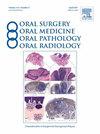上颌双颌伴牙性囊肿:一个不寻常的实体
Oral surgery, oral medicine, oral pathology, oral radiology, and endodontics
Pub Date : 2022-01-05
DOI:10.3390/oral2010001
引用次数: 4
摘要
在x光片上可能偶然发现多余的牙齿。当发生阻生时,可能会出现与不同问题相关的临床症状,如出牙失败、牙移位、牙根吸收或囊性病变。它们可以发生在原牙列和恒牙列,也可以发生在上颌骨和下颌骨,在有综合征的患者中可以是单个或多个。中牙是最常见的阻生牙,在儿童年龄出现在上颌中门牙之间。第三磨牙远端多出的牙齿是罕见的,通常是阻生的,称为双臼齿。46岁男性,主诉上颌骨左侧疼痛。全景x线片显示右侧阻生上颌第四磨牙位于第三磨牙后方,并伴有冠周透光度。在局部麻醉下手术摘除多牙,冠状周围病变去核。组织病理学检查与诊断一致的含牙囊肿与阻生双臼齿。愈合顺利,患者仍无症状。上颌双口瘤的发生是罕见的,而与含牙囊肿的关联则更为罕见。本文章由计算机程序翻译,如有差异,请以英文原文为准。
Maxillary Distomolar Associated with Dentigerous Cyst: An Unusual Entity
Supernumerary teeth may be encountered as an incidental finding on a radiograph. When impacted, they may be associated with clinical signs related to different problems such as failure of eruption, teeth displacement, root resorption or cystic lesions. They may occur in primary and permanent dentition, in both the maxilla and mandible and can be single or multiple in patients with syndromes. Mesiodens is the most commonly impacted tooth and appears between the central maxillary incisors in pediatric ages. Supernumerary teeth distal to the third molar are rare, usually impacted and referred to as a distomolar. A 46-year-old male consulted with the main complaint of pain on the left side of the maxilla. A panoramic radiograph revealed a right impacted maxillary fourth molar located posterior to the third molar associated with a pericoronal radiolucency. The supernumerary tooth was removed surgically under local anesthesia and the pericoronal lesion enucleated. Histopathological examination was consistent with the diagnosis of a dentigerous cyst associated with an impacted distomolar. Healing was uneventful, and the patients remained asymptomatic. The occurrence of a maxillary distomolar is rare and even rarer the association with a dentigerous cyst.
求助全文
通过发布文献求助,成功后即可免费获取论文全文。
去求助
来源期刊
自引率
0.00%
发文量
0
审稿时长
1 months

 求助内容:
求助内容: 应助结果提醒方式:
应助结果提醒方式:


